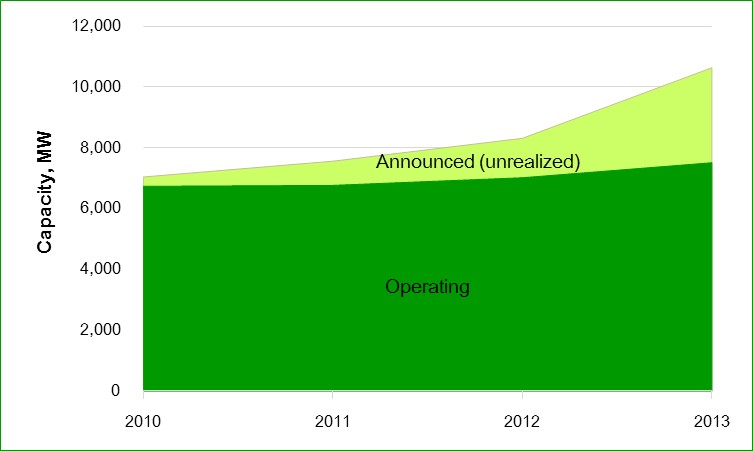This post includes an excerpt from the feature article in the November/December edition of Wood Bioenergy US (WBUS) written by Brooks Mendell and Amanda Lang. The article reviews recent developments in the wood power sector, and projects the future electricity generation and wood use of the sector in the US for the next ten years.
Wood-sourced electrical power generation, a long-time source of energy in the United States, maintains a stable profile with little likelihood for meaningful long-term growth as a share of either total or renewable domestic energy production. Efforts to accelerate, highlight and subsidize wood electricity over the past ten years correspond to total wood electricity growth of 4.7% for the period, which accounts for approximately 1% of total US electricity generation. Within the renewable energy sector, wood electricity continues to lose market share to other sources such as wind. External factors directly affecting sector growth are low natural gas prices and the lack of a federal mandate, such as a Renewable Electricity Standard (RES). Only 21% of the capacity announced by bioelectricity project developers to come online in 2013 actually became operational, based on announcements since 2008 (Figure).
Figure: Operating and Announced US Wood Electricity and CHP Generation Capacity
Note: “operating” includes electricity and CHP plants at manufacturing facilities, including forest industry facilities, as well as existing and stand-alone facilities that came online.
Overall, wood bioenergy accounts for a small portion of wood use in the US. Forest industry mills consume ~500 million green tons of wood per year. Pulpwood and logging residue use from all viable bioenergy applications, including wood pellets, could range from 4% to 10% of the total wood use of the forestry sector over the next ten years. Of this 10%, if the sector grows to that level, pellets bound offshore would account for 40%.
The largest wood power projects announced in the United States over the past ten years have been associated with utilities or greenfield power plants in states with Renewable Portfolio Standards (RPS) and in expectation of a national RES. However, current tracking of announced projects indicates reduced policy expectations and changes in the energy sector associated with natural gas effectively diminished the urgency and incentives for those large-scale projects. While wood electricity capacity and generation increased over this time, the rate and magnitude of these increases have been modest relative to expectations. In practice, the wood electricity sector has thrived where it remains operationally logical: in industrial settings that are already configured to (1) procure or produce residual woody biomass supplies and/or (2) leverage combined heat and power (CHP) synergies.
WBUS Market Update: As of December 2014, WBUS counts 426 announced and operating wood bioenergy projects in the U.S. with total, potential wood use of 121.1 million tons per year by 2023. Based on Forisk analysis, 297 projects representing potential wood use of 84.6 million tons per year pass basic viability screening. To download the free WBUS summary, click here.


Leave a Reply